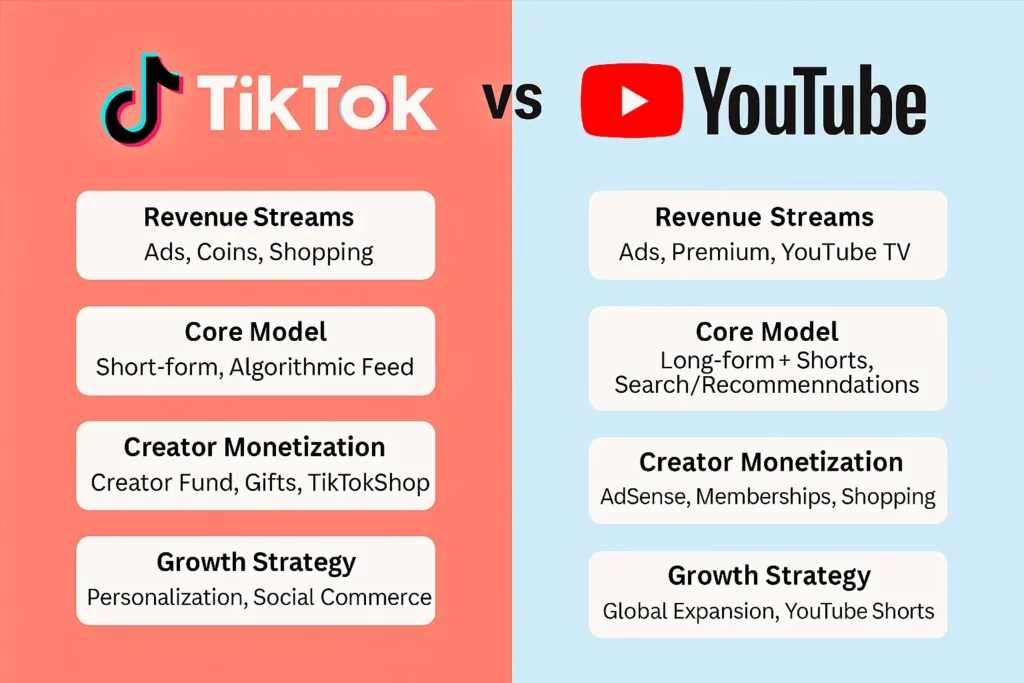In the fast-evolving world of content and creator-driven platforms, TikTok and YouTube continue to lead the digital media revolution in 2025. Both have redefined how users engage with video, how creators earn, and how brands market—but their business models are fundamentally different.
Whether you’re a startup founder, app entrepreneur, or someone ideating a short video platform, understanding these two giants’ models could be your blueprint to success.
- Should you go all-in on algorithmic short-form content like TikTok?
- Or follow YouTube’s path of creator monetization, ad revenue sharing, and long-form content engagement?
This blog dives deep into the TikTok business model vs YouTube business model, unpacking revenue strategies, cost structures, partnerships, and growth levers. Plus, we offer practical insights on which model best suits your startup vision in 2025.

What is TikTok?
TikTok, developed by ByteDance, is a short-form video platform that allows users to create, share, and discover 15–60 second videos. Since its global launch in 2018, TikTok has grown explosively, especially among Gen Z and Millennials.
Key Highlights:
- Personalized feed powered by AI (the “For You Page”)
- Viral trends, music syncing, and filters
- Integrated monetization tools for creators
- In-app shopping, TikTok Live, and branded content
In 2025, TikTok is more than an entertainment app—it’s a mobile-first video economy with commerce, advertising, and community wrapped in one experience.
What is YouTube?
YouTube, a Google-owned platform since 2006, is the world’s largest video-sharing site. Originally built for long-form content, YouTube has since diversified into:
- YouTube Shorts (TikTok-style)
- YouTube Premium (ad-free + music)
- YouTube TV (live streaming)
- YouTube Music
As of 2025, YouTube remains a content powerhouse with a massive creator economy and enterprise-grade monetization opportunities.
Business Model of TikTok
1. Revenue Streams
- Advertising (Main Driver):
- In-feed ads
- Branded hashtag challenges
- TopView ads
- Spark Ads (boosting organic content)
- TikTok Creator Marketplace
- Brands partner directly with influencers
- TikTok Shop & Live Shopping
- Affiliate commissions, product sales
- TikTok Coins
- In-app purchases for tipping creators
- Sponsorship & Brand Deals
- Cross-promotion of products/services
2. Cost Structure
- AI R&D for recommendation algorithms
- Content moderation (manual + AI)
- Creator fund payouts and live stream commissions
- Marketing and expansion into new markets
- Infrastructure (cloud storage, CDN bandwidth)
3. Key Partners
- Brands and advertisers
- Influencers and creators
- E-commerce platforms (Shopify, Amazon)
- Music labels (licensing content)
- Payment gateways
4. Growth Strategy
- Localized content & regional creator support
- AI-powered personalization
- Social commerce integrations (TikTok Shop)
- Global expansion with tailored content
- Acquisition of AI, AR, and video editing startups
Learn More: Business Model of TikTok: How the App Makes Billions
Business Model of YouTube
1. Revenue Streams
- AdSense Advertising (Primary Source)
- Pre-roll, mid-roll, and display ads
- Ads on Shorts (2023 revenue share model introduced)
- YouTube Premium
- Subscription-based (ad-free experience)
- YouTube Music
- Streaming subscriptions
- Super Chat, Stickers, Channel Memberships
- Fan support & tipping model
- Partner Program Revenue Split
- 55% creators, 45% YouTube
- YouTube Shopping
- Product integrations & affiliate links
- YouTube TV
- Live channels with ads/subscriptions
2. Cost Structure
- Video hosting and global CDN infrastructure
- Licensing fees (music and third-party content)
- Creator payouts and Super Chat commissions
- Engineering and product development
- Content moderation, AI/ML model training
3. Key Partners
- Google AdSense Network
- Creators and MCNs (multi-channel networks)
- Music labels and publishers
- Brands and advertisers
- Telecom and smart TV manufacturers
4. Growth Strategy
- Expansion of Shorts to rival TikTok
- Enhancing creator tools and analytics
- Global penetration via local language content
- Integration with Google services (Search, Android)
- Pushing Premium + TV subscriptions
Learn More: Business Model of YouTube: Revenue Strategy & Key Insights
Comparison Table: TikTok vs YouTube
| Feature / Factor | TikTok | YouTube |
| Parent Company | ByteDance | Google (Alphabet Inc.) |
| Core Model | Short-form, social discovery | Long-form + short-form (hybrid) |
| Main Revenue | Ads, coins, affiliate, shopping | Ads, Premium, YouTube TV |
| Creator Monetization | Creator Fund, Gifts, TikTok Shop | AdSense, Memberships, Super Chats |
| Commerce Integration | Strong (TikTok Shop) | Moderate (Shopping integrations) |
| AI/Personalization | Advanced algorithmic feed | Search + recommendation mix |
| User Base (2025) | ~1.6B active users | ~2.7B active users |
| Monetization Scale | Emerging markets, live shopping | Mature ad ecosystem, global ads |
| Preferred Content Type | Viral, meme, dance, trend | Tutorials, vlogs, long-form series |
| Developer Ecosystem | Limited API access | Strong API, Studio, analytics |
Pros & Cons of TikTok Model
Pros:
- High engagement & virality potential
- Creator monetization via shopping, gifts
- Short-form content = low barrier to entry
- Strong mobile-first strategy
- Algorithm boosts discoverability
Cons:
- Content churn rate is high
- Ad model still maturing
- Brand safety & moderation concerns
- Limited monetization for long-form creators
- Platform bans in some regions
Learn More: Business Model of YouTube: Revenue Strategy & Key Insights
Pros & Cons of YouTube Model
Pros:
- Established monetization structure
- Long-form + short-form support
- Strong SEO visibility (Google integration)
- More stable creator income (ads, memberships)
- Global language and niche support
Cons:
- Algorithm favors long-form consistency
- Ad revenue volatility based on viewership
- Higher content production cost
- Stiff competition in saturated niches
Market Data: Growth, Revenue, Funding
| Metric | TikTok | YouTube |
| 2024 Revenue | $20B+ (est.) | $40B+ (Alphabet filings) |
| Creator Payouts (2024) | $3.5B+ | $15B+ |
| Funding | Private (ByteDance valuation $250B) | Public via Alphabet (GOOG) |
| Active Users (2025) | 1.6B+ | 2.7B+ |
| Top Markets | US, India (Ban lifted), SEA, Brazil | Global, incl. US, India, EU |
Which Model is Better for Startups in 2025?
The better model depends on what you’re building:
- If you’re building a trend-driven, fast-consumption app where user-generated content drives engagement and virality, TikTok’s model is a better fit. Its short-form format and algorithmic feed offer faster growth and lower production costs.
- But if your app aims to build creator loyalty, long-term monetization, and integrate with established ecosystems like Google, YouTube’s model offers greater monetization maturity and audience diversity.
Choose TikTok-style if…
- You’re launching a short video app for entertainment, music, or trends
- Your goal is maximum engagement with minimum production time
- You want to embed social commerce, tipping, and virality
- You’re targeting Gen Z and mobile-first audiences
Launch Your TikTok Clone Solution with Miracuves.
Choose YouTube-style if…
- You’re building a content-rich platform with multiple revenue channels
- You plan to offer subscriptions, live TV, and premium access
- You aim for SEO-rich long-form content + shorts
- You’re targeting diverse creators and advertisers
Launch Your YouTube Clone Solution with Miracuves
Conclusion
In 2025, TikTok and YouTube represent two dominant but distinct business models in the creator economy.
- TikTok thrives on trends, short-form innovation, and commerce-driven virality.
- YouTube excels with its creator economy depth, monetization diversity, and long-form dominance.
At Miracuves, we help startups build platforms modeled after world-class giants. Whether you want to develop a TikTok-like short video platform or a YouTube-style content ecosystem, our clone development solutions provide the technology, scalability, and speed you need.
Let’s build your creator-driven empire, together.
FAQs
1. What is the main difference between TikTok and YouTube’s business model?
TikTok is built around short-form, ad-lite, commerce-driven content, while YouTube offers diversified monetization via ads, subscriptions, memberships, and long-form video.
2. Which platform is better for new creators?
TikTok offers faster growth for new creators through its algorithm, but YouTube provides more stable monetization for long-term success.
3. Can I monetize short videos on YouTube like TikTok?
Yes, YouTube Shorts now includes monetization options with ad revenue sharing and fan support features.
4. Is TikTok profitable?
TikTok is rapidly increasing its revenue through ads, shopping, and coins, but remains privately held, so its exact profitability is undisclosed.
5. Can I build a TikTok or YouTube clone for my startup?
Absolutely. Miracuves offers powerful TikTok and YouTube clone solutions tailored for content entrepreneurs, complete with monetization tools, analytics, and user engagement features — all starting at just $2899.








